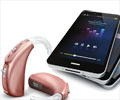Researchers have developed a novel cell phone imaging algorithm that can diagnose medical conditions in point-to-care settings.

TOP INSIGHT
The research has important implications in the diagnosis and management of diseases in the healthcare industry.
Through the analysis of more than 10,000 images, the researchers have been able to demonstrate that the saturation method they developed consistently outperformed existing algorithms under a wide range of operating field conditions. Their findings, published in the journal Analyst of the Royal Society of Chemistry, is a step forward in developing point-of-care diagnostics by reducing the need for required equipment, improving the limit of detection, and increasing the precision of quantitative results.
“Smartphone cameras are optimized for image appearance rather than for quantitative image-based measurements, and they can’t be bypassed or reversed easily. Furthermore, most lab-based biological and biochemical assays still lack a robust and repeatable cell phone analogue,” said Waseem Asghar, Ph.D., lead author and an assistant professor in FAU’s Department of Computer and Electrical Engineering and Computer Science. “We have been able to develop a cell phone-based image preprocessing method that produces a mean pixel intensity with smaller variances, lower limits-of-detection, and a higher dynamic range than existing methods.”
For the study, Asghar and co-authors Benjamin Coleman and Chad Coarsey, graduate students in the Asghar Laboratory in FAU’s College of Engineering and Computer Science, performed image capture using three smartphones: the Android Moto G with a 5 megapixel (MP) camera; the iPhone 6 with a 12 MP camera, and the Samsung Galaxy Edge 7 with a 12 MP camera.
They tested for image capture at various conditions, measured algorithm performance, tested sensitivity to camera distance, tilt and motion, and examined histogram properties and concentration response. They also examined limit-of-detection as well as properties of saturation, ambient lighting levels and relationship with red-green-blue (RGB) color space. Cell phone images are natively stored as arrays of RGB pixel intensities, commonly referred to as color channels.
Asghar, Coleman and Coarsey also applied the test to an ELISA (enzyme-linked immunosorbent assay), a plate-based assay technique designed for detecting and quantifying substances such as peptides, proteins, antibodies and hormones. They discovered that for HIV, saturation analysis enabled an equipment-free evaluation and a limit-of-detection was significantly lower than what is currently available with RGB methods.
“The research taking place in the Asghar Laboratory at Florida Atlantic University has important implications for diagnostic medicine and the delivery of health care in developed as well as developing countries,” said Stella Batalama, Ph.D., dean of FAU’s College of Engineering and Computer Science. “Professor Asghar and his team are driven to continue to develop cutting-edge technology that has the ability to remotely detect and diagnose diseases rapidly, accurately and inexpensively. This latest algorithm they have developed is one of the many advances they are making in this field.”
Source-Eurekalert
 MEDINDIA
MEDINDIA




 Email
Email




